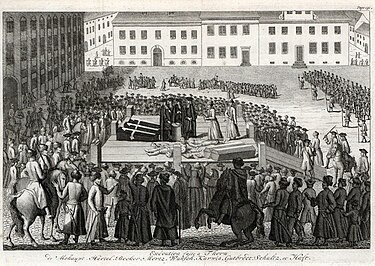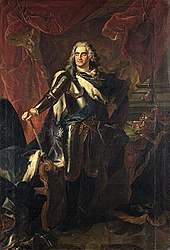Thorner blood court

The Thorner blood court was the execution of ten citizens in Thorn in Polish Prussia on December 9th, 1724 after previous riots against the local Jesuit monastery ( Thorner tumult ).
prehistory
Thorn, with its mostly German population, was mostly Protestant (mostly Lutheran ) since 1557 . A new Jesuit monastery with a grammar school should therefore strengthen the Catholic influence in the city. In the course of the following decades, denominational and political pressure from the Polish state increased. A Polish garrison, the Crown Guard, came into town and placed heavy loads on it. There were repeated conflicts between the Protestant population and Catholic high school students.
Thorner tumult
During the Corpus Christi procession on July 16, 1724, fights broke out between Catholic high school students and Thorner citizens. A Protestant high school student was abducted to the Jesuit school and held there. An angry crowd gathered in front of the school and did not leave the square even after the boy was released. All attempts to pacify the situation failed, so that the crowd finally entered the school and monastery and devastated them.
process
At the initiative of the Jesuits, the incidents were investigated in detail by a royal commission. On October 30th, the mayors Rösner and Zernecke and twelve other citizens were sentenced to death by the royal court in Warsaw . The Marienkirche was the last Protestant church to become Catholic and given to a new Bernardine monastery. Half of the councilors' seats and ' Schöppens' seats were to be occupied by Catholic citizens in future, and the Protestant grammar school was closed.
There were protests and petitions, including from the Prussian King Friedrich Wilhelm I.
Executions

The convicts were offered a conversion to the Catholic faith in order to avoid execution. Some converted , Jakob Heinrich Zernecke was pardoned without converting .
On December 9, 1724, Johann Gottfried Rösner and nine other citizens were beheaded by the sword . Polish troops under the command of Jerzy Dominik Lubomirski secured the execution. On the day of the execution, the first Catholic mass was celebrated in St. Mary's Church.
aftermath
The executions caused a sensation across Europe and were reflected in over 165 pamphlets and hundreds of newspaper articles. The strongest protest came from the neighboring Kingdom of Prussia . King Friedrich Wilhelm I was very upset. England sent a special envoy to the Reichstag in Regensburg and the Warsaw court. The events in Thorn seriously impaired the image of Poland in Europe. During the later partition of Poland , Voltaire denounced the religious intolerance of the Poles, referring to the events of 1724.
The majority of the council in Thorn remained Protestant, and the Protestant grammar school was able to reopen after a year.
In art
The Thorner Blutgericht has inspired numerous literary adaptations. The following are to be mentioned:
- Ewald Hering : The sad Thorn. Story from the beginning of the last century . 1826
- Adolf Prowe : The Thorner blood court. A story from 1866
- Ernst Wichert :
- The mayor of Thorn . Novel 1891
- The Thorner tragedy . Novel 1902
- Fritz Schawaller : The blood court in Thorn . A drama in four acts 1905
- Julius Pederzani-Weber : The Thorner blood court . Story around 1910
- Karl Hans Strobl : The dark stream . Novel 1922
- Arnold Krieger : Outrage in Thorn. Vistula German novel 1939
It also found its way into
- Gustav Freytag's novel The Ancestors , 1872
Remembrance day
The Evangelical Church in Germany commemorates the victims of the Thorner Blood Court with a day of remembrance in the Evangelical Name Calendar on December 7th .
See also
- Franz Georg Jauch , 1724 captain of the infantry regiment Guard of the King and company commander in the Thorn fortress
literature
Current research literature
- Stanisław Salmonowicz: The Toruń Uproar of 1724 . In: Acta Poloniae Historica 47 (1983), pp. 55-79
- Stefan Hartmann: The Poland policy of King Friedrich Wilhelm I of Prussia at the time of the "Thorner Blood Court" (1724-1725) . In: Research on Brandenburg and Prussian History , New Series 5 (1995), pp. 31–58
- Martina Thomsen: "The Sorrowful Thorn". Daniel Ernst Jablonski and the Thorner tumult of 1724 . In: Joachim Bahlcke , Werner Korthaase (eds.): Daniel Ernst Jablonski (1660–1741). Court preacher, academy president, early enlightener. Studies on life, work and work . Wiesbaden 2008 (Jabloniana. Sources and research on European cultural history of the early modern period 1), pp. 1–24
- Martina Thomsen: The Thorner tumult 1724 as the subject of the German-Polish nationality conflict. On the controversy between Franz Jacobi and Stanisław Kujot at the end of the 19th century . In: Zeitschrift für Geschichtswwissenschaft 57 (2009), pp. 293-314
Contemporary sources
- Johann Theodor Jablonski : Das Betrübte Thorn, Or the story as it turns out to Thorn From July 11th, 1724. bit up to the present time: Carefully collected from reliable news, and communicated to the right- and truth-loving world for judgment. Haude, Berlin 1725. ( Digitized BSB , Google book )
- Authentic news of the uproar that was aroused at gates and tightened according to the requirements of justice ... Regensburg 1725 ( Google Book )
- True historical news of the tumult of the common people that happened on July 16, 1724 at Thorn in Prussia ... Jena 1724. ( Google book )
- Extraordinaire talks in the realm of those who died ... Between the Thornian Ober-President Roessner ... and the tribe father, also founder of the Jesuit order, Ignatio von Loyola ... 1725. ( Google book )
- Johann Theodor Jablonski: Thornische Memories, Wherein the city of Thorn im Königl, which died in the year of Christ 1724 and previous times. Pohlnischen Hertzogthum Preussen Is presented thoroughly by an impartial pen. Haude, Berlin 1726. ( digitized BSB )
Web links
- Johann Gottfried Rösner on Deutsche-und-Polen.de
Footnotes
- ^ To the events of Franz Jacobi: Rösner, Johann Gottfried . In: Allgemeine Deutsche Biographie (ADB). Volume 53, Duncker & Humblot, Leipzig 1907, pp. 501-504.
- ↑ He described the events in Thornische Chronica ... History of this city . ( Digitized version )
- ↑ Martin Schulze Wessel : Religious intolerance, cross-border communication and the political geography of East Central Europe in the 18th century . In: Jörg Requate, Martin Schulze Wessel (ed.): European Public Transnational Communication since the 18th Century , Campus Verlag, Frankfurt / Main, 2002, p. 77. ISBN 3-593-37043-3 [1]
- ↑ The victims of the Thorner Blutgergericht in the Ecumenical Lexicon of Saints
